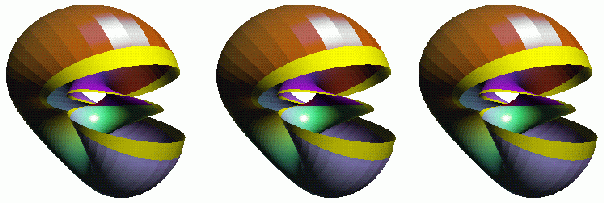This page http://new.math.uiuc.edu/595index.html was last updated 14dec15 by
gfrancis@illinois.edu.
 click me
click me
Links to
Class Webpages 2015.
Class Matters 2015.
ISL busroute 2015 for the Fieldtrip
CAVE tours 2015 for the Fieldtrip
DPGraph
Piazza Discussion Forum
PDF of MathViz Powerpoint presented in MA499 6may15
Optiverse Video on YouTube.
Last taught Spring 2012.
MA595 Fall 2015 Course in Geometry:
COMPUTER ANIMATION & MATHEMATICAL VISUALIZATION
Professor
George Francis
1pm MWF 102 Altgeld Hall
Recommended Text: Francis, A Topological Picturebook, Springer Paper Back, 2006.
We present the geometrical principles of real-time interactive computer
animation (RTICA)
for
mathematical visualization as it is practiced in the
classroom, research seminar, and webpages but also in immersive virtual
environments from head-mounted displays (Oculus Rift) to the CAVE
at the Illinois Simulator Lab (ISL)
of the Beckman Institute.
Subject of the Course
Topics include the structure of the OpenGL graphical pipeline, the
polyhedral encoding of surfaces as triangular meshes, the geometry of
linear and aerial perspective (light and shade), the representation of
the 3D group of Euclidean motions in 4D homogeneous coordinates, the algebra
of 3D rotations in terms of unit quaternions SU(2), projective spaces and
their Euclidean, spherical and hyperbolic metrics.
The course also includes a survey of classical topics including binocular
optics and color theory, Haussdorff dimension and fractals, chaos and
strange attractors, Wolfram's cellular automata, Barnsley's iterated
function systems, Julia and Mandelbrot sets, discrete and continuous
logistic equations, and the Lienard-VanderPol dynamical system.
All available topics are online, and students will be invited to request
for class elaboration and discussion, those topics of particular interest
to them. For their course grade students will create a webpage and give
a presentation to the class on a topic of their choosing.
Prerequisites and Practicum
Prospective students should have a good spatial intuition,
some artistic abilities or ambitions, and a solid grounding in
linear algebra and vector calculus. They may participate in
a concurrent tutorial, on useful line and surface graphics tools
for the classroom and their dissertation, that may, but does does
not require programming.
Students with experience programming in any computer language, such as
BASIC, Javascript, C/C++, Python, or Mathematica, may gain 2 additional
credits of independent study for a
graphics programming project
appropriate to the course and tailored to the proficiency
of the student. In particular, projects suitable for a virtual
environment at ISL are not only supported but strongly encouraged.
Students inexperienced in programming may take an individual study course
to learn how to program a mathematical RTICA.
 click me
click me